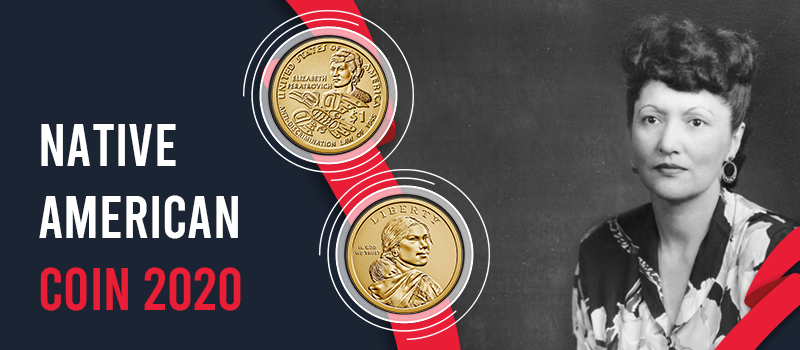Native American coin 2020

In 2009, the U.S. mint started releasing Native American $1 coins with a reverse depicting a Native American theme to honor an individual or a Native American tribe with the Sacagawea obverse. The Sacagawea obverse design was used in the Golden dollar released first in 2000 honoring the Native American Lemhi Shoshone woman Sacagawea carrying her infant son Jean-Baptiste during her travels as interpreter with the Lewis-Clark expedition in the Louisiana territory.
This year the reverse would depict Elizabeth Peratrovich, the Tlingit civil rights activist who brought about the signing of the Anti-discrimination Act of 1945.
Elizabeth Peratrovich - Anti-discrimination legend
Elizabeth Peratrovich is a legend in Alaska because she managed to achieve something that took 20 more years for the rest of the United States to wake up to. An Anti-discrimination Act!
When Elizabeth and her husband Roy Peratrovich both with origins in the Tlingit nation, wanted to get a house in a nice suburb in Alaska in 1941, they couldn’t. The reason: social discrimination against Native Americans or Indians as they were called then. It was common to see notices like ‘No dogs, No natives’ in public places like theatres, and restaurants. Elizabeth and Roy petitioned the territorial governor, Ernest Gruening, to ban the "No Natives Allowed" signs initially. The bill was defeated when it was proposed initially in 1943.
When it was reintroduced in 1945, territorial senator Allen Shattuck of Juneau asked, "Who are these people, barely out of savagery, who want to associate with us whites, with 5,000 years of recorded civilization behind us?"
When it was her turn, Elizabeth stood up to address the territorial Senate. She said to thunderous applause, “I would not have expected that I, who am barely out of savagery, would have to remind gentlemen with five thousand years of recorded civilization behind them, of our Bill of Rights”. Her testimony was considered the clincher to pass the act.
The Anti-discrimination Act was passed in the territory of Alaska on February 16th, 1945, 20 years before the Civil Rights Act of 1964. The day is considered as ‘Elizabeth Peratrovich day’ in Alaska.
Native American coin 2020 – The Design
The obverse design retains the “Sacagawea” design first produced in 2000. The reverse design features a portrait of Elizabeth Peratrovich, whose advocacy was considered a deciding factor in the passage of the 1945 Anti-Discrimination Law in the Alaskan Territorial Government. The foreground features a symbol of the Tlingit Raven moiety, of which she was a member. United States Mint Medallic Artist Phebe Hemphill created the design and sculpted it.
This entry was posted in General on March 20, 2020 by lavanya kannan

Leave a comment